For this church:    |
|
 St David’s St David’sMission Church |
 Inside St David’s Inside St David’sMission Church |
St David’s Mission Church, was surrounded by a mixture of hedging and wooden fencing. The congregation entered through a wooden gate with a double notice board, which advertised the weekly services. On the outside of the building, a single lamp hung on the wall, providing a warm welcome on a dark winter's night. Just as today, people were called to the service by the ringing of a solitary bell, this was situated on the church roof and the bell rope ran from the roof down the outside wall.
The church, built of wood and corrugated iron, could accommodate a congregation of 130 people, who sat on rows of wooden chairs. Oil lamps that were suspended from the roof provided illumination, and music was played on a reed-organ that stood at the front. A dedication service was held on Friday, 3rd March 1905, which the Rev C Webb, Vicar of Mansfield Woodhouse, and the Rev W H Foster, conducted.
The first person to be responsible for two services each Sunday was Captain Cunliffe of the Church Army. By 1907 Captain Tomlinson was believed to have been in charge of the church. In April 1908 the Rev Harry Bull was the curate with responsibility for St David’s Mission Church.
As the population of Forest Town increased, it became evident the little Mission Church was no longer adequate to accommodate the people of the village, and at the end of 1908, a fund was established to build a new church. The Duke of Portland once again showed his generosity by giving one acre of land to site both the church and a parsonage. In addition, he gave the sum of £2,000. The Bolsover Colliery Company gave a donation of £600 and said they would contribute annually to the curate fund. The village people were greatly encouraged and began organising fund-raising events.
 The new church next The new church nextto the old one (Photograph from 1913) |
The new stone church was built 1910/11 and the wooden church building of St David's continued to serve the community as the Parish Rooms/Mission Hall (Church Hall) for at least another 50 years. Both social and welfare events were held there. It was eventually demolished in the 1960's.
Louis Ambler FRIBA, of Temple Chambers, London was the architect asked to design the new Anglican Church to be built in Forest Town. He soon had to modify his original designs for the church due to a lack of finance. Despite the substantial donations and fund-raising by people of the village, this still fell short of the sum required.
From 1908, a great deal of correspondence was generated over the building of both the new church and a house for the clergy known as the parsonage. It was decided that the church should only provide the accommodation for the necessary population, with provision being made for the church to be enlarged when this was required.
 Laying the Laying theFoundation Stone |
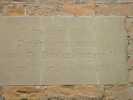 The stone layed The stone layedin 1910 |
In July 1910, the foundations of the new church were laid and the building work progressed. A special memorial stone was placed in the east wall of the building, and the Duke of Portland performed the official stone laying ceremony on Saturday, 5th November 1910.
The new church was to have a nave, chancel, sacristy, clergy vestry, choir vestry and organ chamber. The external walls of the church were to be of Bulwell stone with Weldon stone dressing, the interior to be lined with bricks and plastered. Ancaster stone was to be used for the columns and red Broseley tiles for the roof. The roof itself was fir and stained brown. Oak was chosen for the outer doors and Canary whitewood for those inside the church. Louis Ambler designed a font made of Ancaster stone to be situated at the West End of the nave, and he also designed and made the oak pulpit.
Plans for the north aisle and morning chapel were deferred to reduce expenditure. (The north aisle was eventually built in 1936, but the morning chapel has never been built). The principal contractor was Charles J Vallance and Sons. Other items were provided as follows:
Door Hinges & Furniture |
Jones & Willis Ltd |
|
Clergy Choir Seats & Pews |
Thomas Ullathorne |
|
Wood Block Flooring |
The British Flooring Co |
|
Wrought Iron Gas Fittings |
J W Singer & Sons |
|
Heating |
Thomas Danks & Co Ltd |
|
“Coal Port-Brosley” Tiles |
William Exley & Sons |
|
Ancaster Stone Font |
Bowman Bros. |
A summary of the building account dated June 1911 shows the total net cost for the church was £3,404 17s 5d. A separate account reveals that for his work in preparing sketch plans, specifications etc Louis Ambler the architect was paid £287 17s which included £29 17s for travel and other incidental out of pocket expenses.
For the coal mining community of Forest Town the new church cost a lot of money. Despite all their fund-raising prior to the stone laying ceremony, in May 1911 the people of the village were still £300 short of the £600 amount they had promised to raise towards the building. A two-day bazaar raised a further £120 helping to reduce the outstanding debt towards the building fund.
 The church soon after The church soon afterit was built in 1911 |
The building of St Alban’s Church progressed and within two months of the fund-raising bazaar the community was once again uniting in a very special ceremonial event, the consecration of their new church. This took place on Sunday, 2nd July 1911. It was a day full of great rejoicing and celebration. In the morning the Bishop of Southwell, clergy and churchwardens, Messrs R Dent and W Pogmore, formed a procession to the church where upon being requested by the churchwardens, the Bishop consecrated both the building and burial ground. In the afternoon a further ceremony took place when the Bishop consecrated the font and internal fittings.
St Alban’s Church was now ready for the people to worship in. The Rev Harry Bull was the first incumbent and remained at the church until 1924. Additional to the regular services, the new church could now be used for baptisms and burials, and it had its own registers, although until 1936 it still came under the parish of Mansfield Woodhouse.
 War graves from War graves fromWorld War I |
Since 1909 baptisms had taken place in the Mission Church but they had additionally been entered in the Mansfield Woodhouse registers. The first page of the burial register contains eight entries, and sadly five of these were children. Soon headstones with carved names and inscriptions began appearing in the churchyard. It was the last resting place for many local people. It was also the last resting place for 29 soldiers and one civilian nurse who died at the nearby Clipstone Camp and its hospital during the First World War.
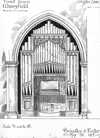 Design drawing Design drawingfor the organ made in 1917 (with thanks to Nottinghamshire Archives Office) |
By 1917 the church were making plans to install an organ. A design by Brindley & Foster was submitted in May 1917 at a cost of £515. This was accepted and the work began. The wonderful musical tones were soon to be heard and it was a great asset to the church.
On 2nd December 1918, when the population of Forest Town had increased to around 3000 people, St Alban’s Church was licensed for marriages. People could now marry in their own village and did not have to go to Mansfield Woodhouse.
In 1927 a fund for a permanent church hall was started, however it was 40 years before this materialised.
In 1928 concerns were expressed that the churchyard was nearly full and the purchase of land for an extension of the churchyard was planned and discussed. The new burial ground was opened in 1929 and is reached from the North East corner, being situated at the rear of the Primary School.
On 19 November 1929 a Memorial Altar and Credence table was dedicated by the Bishop. They are situated on the East Wall of the South Aisle and were made by Arthur Bailey.
In the summer of 1930 the church had a new boiler and electricity was installed.
On Palm Sunday 1931 the Bishop unveiled and dedicated a new Roll of Honour, which was given to the church by the British Legion. The new roll in Bronze with white enamel lettering is situated near the Memorial Altar and replaced the framed temporary roll. At the end of 1931 consideration was being given to raising money to clean the organ and install an electric blower.
1932 was a special year for St Albans Church in which money was raised for the installation of a stained glass window to celebrate the 21st anniversary of its consecration.
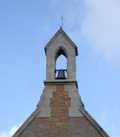 The bell in its The bell in itsturret |
In June 1935 the church bell was replaced.
On the 27 October 1936 Forest Town was created a Parish by Order of the Privy Council.
The church was extended in 1937 when the North Aisle was built. Greenwoods of Mansfield, were the contractors, and the consecration of the extension took place on 29th September 1937.
In 1944 a field at the side of the vicarage was purchased for £550. This became the church recreation field.
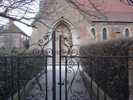 Gates and main door Gates and main door |
The wall that surrounds the churchyard and three pairs of wrought iron gates were erected in 1961 to mark the Golden Jubilee of the Church.
A new church hall was built in 1967 on the church recreational field. The hall was dedicated and opened by the Right Rev G Savage, Bishop of Southwell in March that year. The old hall (St David’s Mission) was then demolished.
Disaster struck the church on 16 July 1968 when a fire was discovered just after 2.00am causing damage to the choir vestry and church roof. The High Altar was damaged beyond repair. Wood that could be salvaged was later used to repair the British Legion Altar. The stained glass window installed in 1932 had a miraculous escape with only the face of St Alban being cracked. The Church was unusable for twelve months, and all services were held in the Church Hall. While the primary object of restoration was to keep the church in its original condition, some improvements were made. The altar steps were removed and the sanctuary floor was lowered in order to obtain more circulation space round the altar. The existing reredos was removed and replaced by a backcloth that occupies the full width of the East wall. Concealed lighting was added over the backcloth. A new altar was made and a simplified altar rail installed. The reredos screen was refitted in a modified form under the West window as a background to the font.
The Rehallowing of the church by the Bishop and Clergy took place on 20th May 1969. A new altar was also consecrated at this service.
From 22nd June to 2nd July 1971 the church celebrated its Diamond Jubilee. A processional cross and two torches were purchased by the parish to commemorate the event.
The old churchyard was closed for burials in June 1987.
In November 1993 a piece of land in the old churchyard was consecrated for interment of cremated remains. This became the Garden of Remembrance.
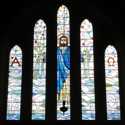 The east window The east window |
1995 was a year of events. In April poplar trees in the extension Churchyard were taken down. A new Book of Remembrance was placed in the church. The east window over the main altar had stained glass installed. The Right Rev Patrick Harris, Bishop of Southwell, dedicated this on 25th June. Over the weekend of 24th and 25th June a Flower Festival was held in the church, and a Local History Exhibition took place in the Church Hall. The theme for both of these was ‘Forest Town Past and Present’.
In March 2002 the Church Hall was closed.
At the end of 2004 alterations to the vestry area of the church had been made and a toilet and kitchen installed.
2006 saw the sale of Church Hall and land. The hall was demolished by the new owner.
In the autumn of 2006 work commenced to make alterations to the path on the east side of the old churchyard to enable general car parking, and parking for the disabled.
At the end of October 2006 a St Alban’s web site was launched.
In January 2008 major work was started to improve facilities and make St Alban’s Church a more versatile place. New electrics, lighting, heating, and a sound & loop system were installed. Both the lighting and heating have been installed with energy saving facilities.
In the main body of the church (the Nave) the rigid wooden church pews were removed, which has made the whole area more flexible. New chairs with cloth seating have been purchased and these can now be arranged to suit any event or occasion. The central floor area is paved with wood blocks surrounded by a new mulberry coloured carpet. This new carpet leads up into the chancel where the choir pews have been retained and to the high altar, and has the effect of joining the new with the old. The church has been redecorated and the walls are cream with a yellow tinge, making it very light but also warm.
At the rear of the church an area has been added to provide light refreshments when needed. Old wood panelling has been used in this area. The vestry has also seen changes and newly installed stairs lead up into what was the roof space, making this now a very useful storage area.
The contractors for the Electrical work and site management were JKE Installations Ltd, Shirebrook. Other contractors were:
| Plumbing & Heating | Taft Plumbing & Heating Engineers, Mansfield | |
| Sound & Loop System | Church Sound Services, Bridgewater, Somerset | |
| Relaying of the Floor | Martin Kingdon, Southport, Merseyside |
For a number of weeks during the alterations the church could not be used for services and these were held in Forest Town Miners’ Welfare.
On Easter Sunday, 23rd March 2008, the congregation were able resume services in St Alban’s Church.
The church celebrated the re-opening on Tuesday, 22nd April 2008, and the Bishop of Sherwood, the Right Revd Tony Porter officiated at this celebration.






